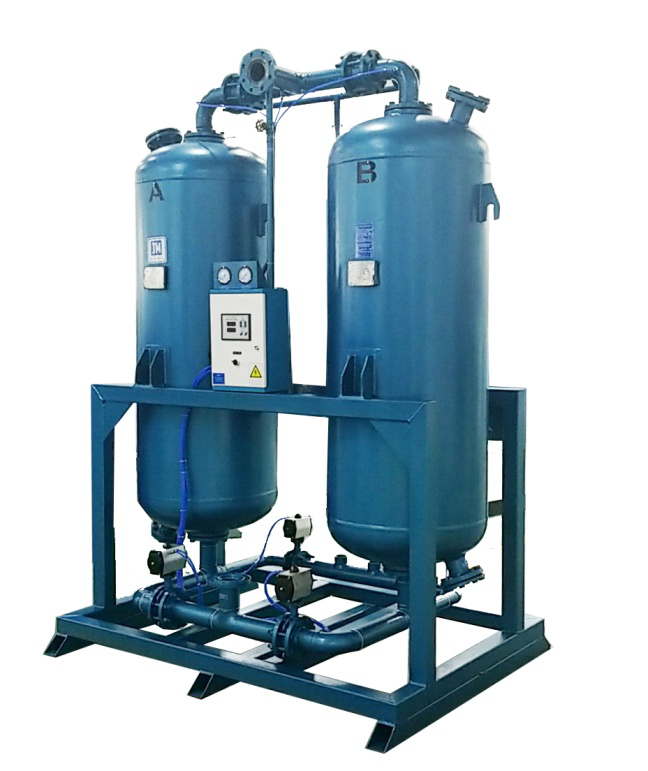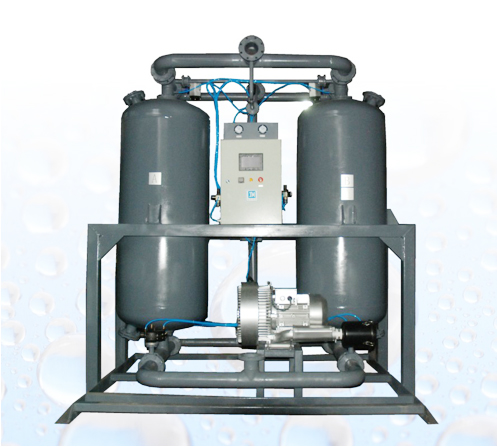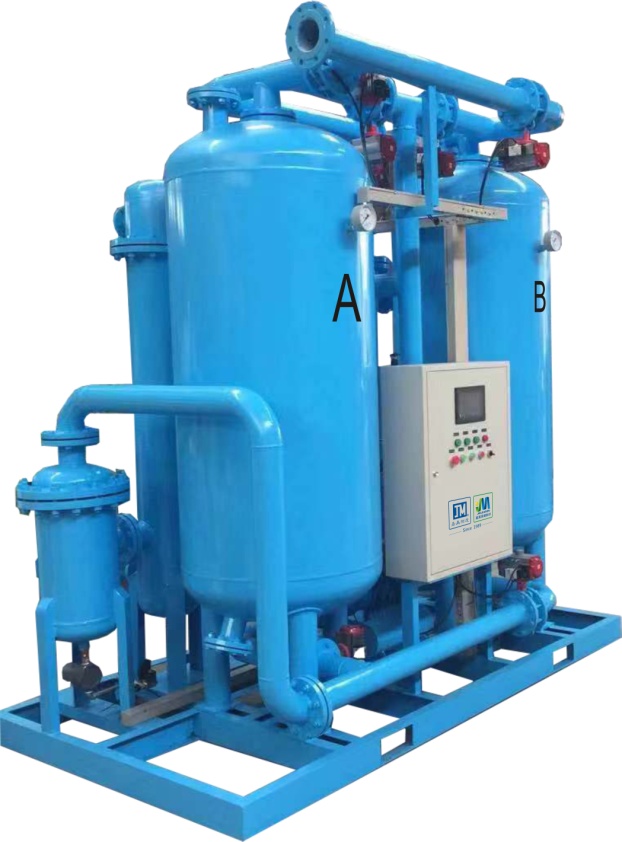According to the different ways of energy saving, the suction dryer can be divided into the following six categories:
1. Non-thermal adsorption dryer
The non-thermal regeneration dryer uses about 15% of the product compressed air to sweep and regenerate the saturated adsorbent.
The advantages are: simple structure, low purchase cost and convenient maintenance;
The disadvantage is that it consumes about 15% of high quality compressed air.
2. Micro-thermal adsorption dryer
Electric heater is used in the micro-heat regeneration dryer. About 7% of the product gas is heated by heater and sent to the regeneration tower to regenerate the adsorbent, then the adsorbent is cooled to normal temperature.
The advantages are: the working cycle is longer than that of the non-thermal regenerative dryer, and the dew point of the air supply is stable;
The disadvantage is that the energy consumption is still large, which consumes not only 7% compressed air, but also a certain amount of electricity.

3. Air Consumption Breeze Regeneration Adsorption Dryer
Micro-air consumption type is to use high-pressure blower to provide power and inhale ambient air for heating and regeneration. In the cooling stage, only about 3% of the finished gas is used to blow the regeneration tower. The energy consumption of air compressor is about 40% lower than that of non-heat and micro-heat type, and it can adapt to various types of air compressors, and realize regeneration according to the load change of the system. Volume regulation can further achieve energy saving and emission reduction, but the high-pressure blower itself will consume energy.

4. Zero Gas Consumption Blow Regeneration Adsorption Dryer
Zero-gas consumption type is to add an intermediate cooler on the basis of micro-gas consumption type. The ambient air inhaled by the blower is heated and regenerated to the adsorbent. In the cooling stage, the hot air circulates through the intermediate cooler and regeneration tower. The regeneration tower is cooled and cooled by a continuous closed cycle. The whole regeneration process basically does not consume compressed air.
Compared with the regenerative dryer with low air consumption blast heating, the model improves the product gas loss caused by the cold blowing of part of the finished gas to the regenerative tower, that is, the power loss of the air compressor, which is more energy-saving than the regenerative dryer with low air consumption blast heating, but at the same time, the pressure loss is relatively larger.
5. Low Gas Consumption Adsorption Dryer for Waste Heat Regeneration
We know that when the gas is compressed, it will produce a lot of compressed heat. Conventional air compressors must reduce the exhaust temperature. Special coolers must be equipped to cool the air to room temperature, and then sent to the purification equipment for drying and purification. In this way, a lot of heat energy will be wasted. Compressed hot regeneration dryer is to recycle this part of high-temperature heat, so that heating regeneration does not lose compressed air, only consume about 3% of the dry compressed air when cold blowing, fully utilizing the waste heat of the compressor to complete the regeneration of adsorbents, so as to save energy to the greatest extent. But at the same time, the exhaust temperature of the air compressor is required to be at least higher than 130 - 150 degrees. In order to reach a better dew point, additional auxiliary heating is needed, thus consuming more energy.

6. Zero Gas Loss Adsorption Dryer for Waste Heat Regeneration
Zero-gas consumption waste heat regeneration dryer also uses high-temperature compressed waste heat as the regeneration heat source of adsorbent. The whole working process is isobaric regeneration and closed cycle (without blower and zero emission). It directly uses compressed heat of air compressor to replace expensive finished gas and blower. In principle, it is more energy-saving than micro-gas consumption adsorption dryer with waste heat regeneration. However, the machine also has obvious defects. One is that if it does not cooperate with auxiliary heating, it often fails to reach the dew point required. The other is that because of the complex pipeline and many elbows, the pressure loss of the machine is relatively large, which increases the load of the air compressor.
Principle of suction dryer:
Adsorptive compressed air dryer uses the special water absorption of activated alumina to absorb moisture in air, so that the dew point of compressed air can reach - 40 C, or even - 70 C.
Adsorption dryer is based on the principle of pressure swing adsorption, non-thermal regeneration (or micro-thermal regeneration) way, through the structure of double-tower Cycle Adsorption to dry your compressed air. One tower absorbs moisture in the air at a certain pressure, the other uses a little dry air slightly higher than atmospheric pressure to regenerate the desiccant in the adsorption tower. After a certain period of time, the two towers switch to each other, so as to ensure the continuous supply of dry compressed air. The working process of 'adsorption regeneration repression' is realized.
The dew point of compressed air is directly related to the cycle period of desiccant (active alumina, molecular nodule) and the inlet temperature of compressed air.
Main features of the suction dryer:
Well-designed adsorption tower body
The large adsorbent bed with contact time of 6.25 seconds ensures that the saturated air entering the dryer dries to the dew point needed and compensates for the natural aging of the adsorbent layer.
Appropriate column size and convection mode of upstream drying and downstream regeneration are conducive to reducing the amount of regenerated gas and avoiding the pollution of adsorbent fluidization and adsorption desk layer.
Slow and complete charging procedure and delayed switching design to eliminate downstream air expansion and balance, and to prevent adsorbent layer movement and abrasion of adsorbent layer
Independent filling and discharge ports for easy replacement of adsorbents
The tower is manufactured in accordance with the international standards for pressure vessels.
Large stainless steel airflow diffuser with reliable structure ensures that airflow uniformly passes through the adsorbent layer and eliminates the flow-relief phenomenon in the tower body.
High Performance Activated Alumina Adsorbent
High compressive strength, abrasion resistance, high temperature resistance, no water dissolving, large surface area and static adsorption capacity.
Main functions of adsorption dryer:
Alarm function for low air pressure; (setting value is 0.45MPa)
Alarm function for excessive temperature of transportation; (setting value is 46 C)
Heater circuit breaking alarm function; (Applicable to micro-thermal adsorption dryer)
Overheat alarm function of heater; (suitable for micro-thermal adsorption dryer)
Superheat protection function of heater; (suitable for micro-thermal adsorption dryer)
Heater Short Circuit Protection Function; (Applicable to Micro Thermal Adsorption Dryer)
The control panel shows the adsorption or regeneration status of the two towers in real time.
Remote Chain Control and Main Abnormal Alarm Function (Universal Serial Interface RS-485)